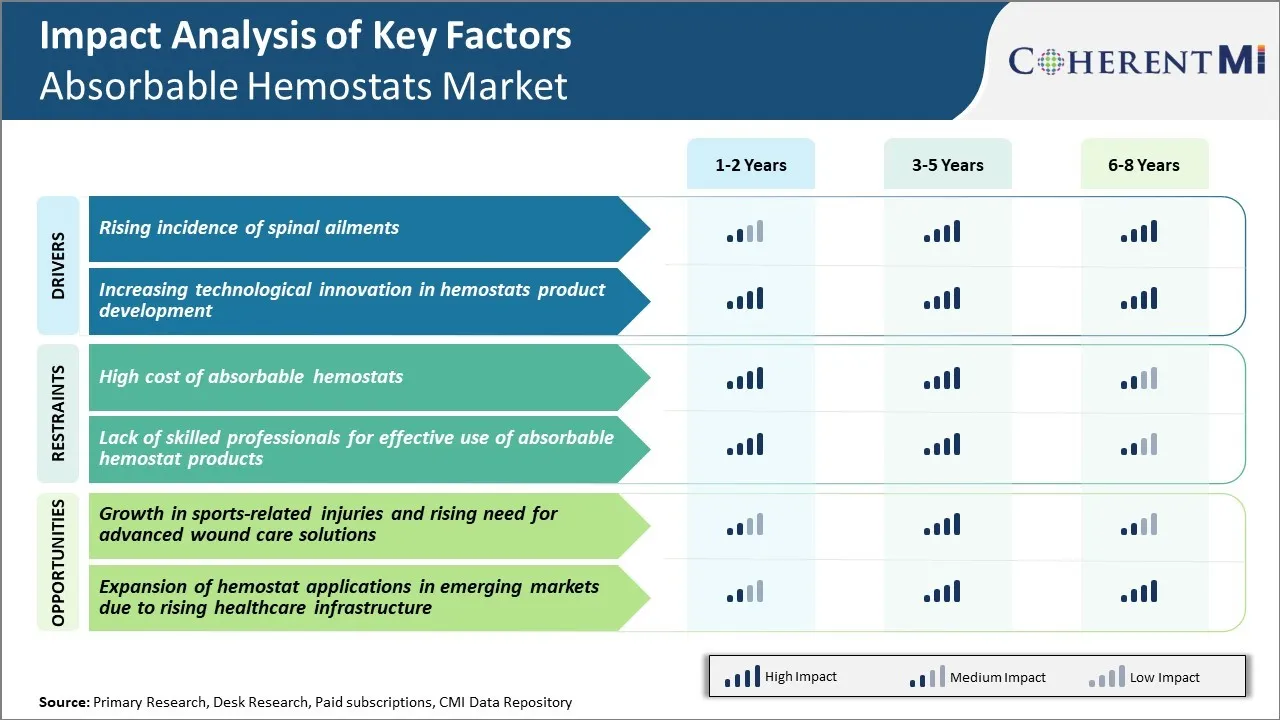Absorbable Hemostats Market Trends
Market Driver - Rising Incidence of Spinal Ailments
There has been significant rise in various types of spinal ailments over the past couple of decades. Spinal issues could range from minor backache caused due to posture or obesity to more critical conditions like slipped disc, damages discs or vertebrae fractures. Aging population across developed nations has also contributed to higher cases of degenerative spine diseases. Prolonged lifestyle associated diseases and lack of physical activity has made populations more prone to spinal disorders. Studies show nearly 80% of Americans will experience back pain at some point which could last from few days to sometimes months.
Spinal surgeries have thus seen substantial increase annually. Whether it is conventional open spine surgery requiring incision or minimally invasive procedures like spinal fusion, decompression surgery etc., all involve certain amount of blood loss. Absorbable hemostats are extensively used in such complex spine surgeries to control bleeding, absorb blood and fluids and promote clotting. Various forms like oxidized cellulose, gelatin matrix thrombin mixtures etc. are preferred depending on severity of bleeding and surgical requirements
Further, as spinal surgeries involving delicate nerves become more advanced, need for minimal blood loss and improved visibility becomes critical for success of such high-stake operations. This drives significant demand for technologically advanced hemostats in spine segment.
Market Driver - Increasing Technological Innovation in Hemostats Product Development
Medical technology industry has been witnessing rapid pace of innovation especially in hemostats domain. Numerous startups and large companies are investing heavily in R&D to develop next generation hemostatic products. There is growing focus on developing combination style hemostats bridging limitations of individual agents. Also, hemostats featuring faster deployment and clotting abilities are being introduced.
For instance, combination of oxidized regenerated cellulose with thrombin or gelatin is gaining favor as they provide dual action hemostasis and sealant effect reducing time in operating room. Similarly, hemostats integrating antibacterial properties are new entrants helping cut down postoperative infections especially important in spinal and brain surgeries.
At the same time, development of resorbable synthetic polymer-based hemostats is opening up new avenues. Compared to natural agent-based options, synthetics provide consistency in performance and absorption properties besides being free from issues like disease transmission.
Advances in material sciences and polymer engineering have enabled design of tailor-made synthetics perfectly suited for specialized surgery requirements. For example, 3D printed hemostats customized as per anatomical areas are new developments. Nanotechnology and drug loading capabilities in hemostats are other innovations unlocking new therapeutic possibilities.

Market Challenge - High Cost of Absorbable Hemostats
One of the major challenges currently being faced by the absorbable hemostats market is the high cost of these products. Absorbable hemostats are manufactured using advanced technologies and materials like oxidized cellulose, polysaccharides, and gelatin to allow for quick clotting and absorption within the body.
However, these advanced production processes and materials come at a significant price. For example, some of the leading absorbable hemostats such as Surgicel and Gelita-Cel cost around $150-200 per unit. This high cost makes absorbable hemostats prohibitive for use in many routine surgical procedures and restricts their adoption to mainly larger and complex surgeries.
The high costs also limit the penetration of these products in price-sensitive developing markets. To address this challenge, manufacturers will need to focus on innovation that allows for cost reduction without compromising on effectiveness. This could include exploring alternative raw materials, streamlining production workflows, and standardizing designs. Overcoming the barrier of high costs will be crucial to realizing the full growth potential of the absorbable hemostats market.
Market Opportunity - Growth in Sports-related Injuries and Rising Need for Advanced Wound Care Solutions
One of the major opportunities for the absorbable hemostats market is the steady rise in sports-related injuries globally. More people are taking up various recreational and competitive sports. However, this has also led to an increase in injuries like muscle tears, bone fractures, and lacerations that often require surgical intervention.
Sports medicine has emerged as a specialized clinical discipline focused on addressing sports-related wounds and injuries. The demand for advanced wound care solutions is witnessing significant growth in this field to aid faster recovery of athletes. Absorbable hemostats that promote quick clotting and healing without leaving any residues in the body have a clear advantage over conventional gauze and cloth wound dressings for sports medicine applications. Their effectiveness in minimally invasive surgeries is also boosting uptake.
With lifestyle disease prevention through regular exercise becoming a priority, the demand for specialized sports injury management and wound care solutions like absorbable hemostats is expected to keep rising in the coming years.